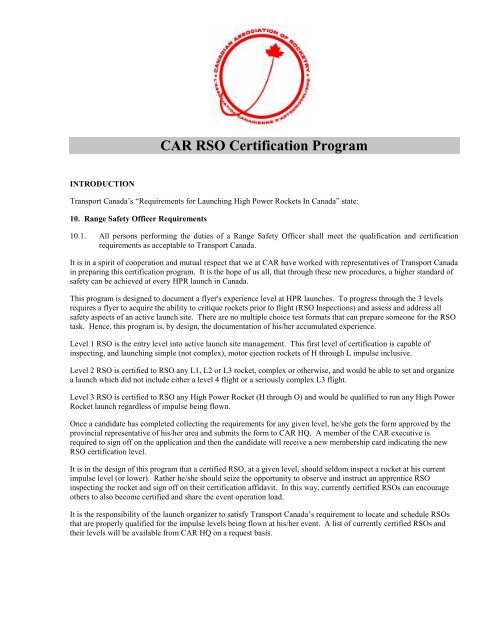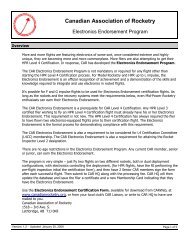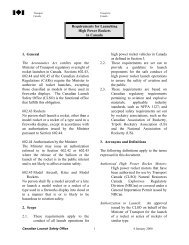CAR RSO Certification Program
CAR RSO Certification Program
CAR RSO Certification Program
You also want an ePaper? Increase the reach of your titles
YUMPU automatically turns print PDFs into web optimized ePapers that Google loves.
<strong>CAR</strong> <strong>RSO</strong> <strong>Certification</strong> <strong>Program</strong><br />
INTRODUCTION<br />
Transport Canada’s “Requirements for Launching High Power Rockets In Canada” state:<br />
10. Range Safety Officer Requirements<br />
10.1. All persons performing the duties of a Range Safety Officer shall meet the qualification and certification<br />
requirements as acceptable to Transport Canada.<br />
It is in a spirit of cooperation and mutual respect that we at <strong>CAR</strong> have worked with representatives of Transport Canada<br />
in preparing this certification program. It is the hope of us all, that through these new procedures, a higher standard of<br />
safety can be achieved at every HPR launch in Canada.<br />
This program is designed to document a flyer's experience level at HPR launches. To progress through the 3 levels<br />
requires a flyer to acquire the ability to critique rockets prior to flight (<strong>RSO</strong> Inspections) and assess and address all<br />
safety aspects of an active launch site. There are no multiple choice test formats that can prepare someone for the <strong>RSO</strong><br />
task. Hence, this program is, by design, the documentation of his/her accumulated experience.<br />
Level 1 <strong>RSO</strong> is the entry level into active launch site management. This first level of certification is capable of<br />
inspecting, and launching simple (not complex), motor ejection rockets of H through L impulse inclusive.<br />
Level 2 <strong>RSO</strong> is certified to <strong>RSO</strong> any L1, L2 or L3 rocket, complex or otherwise, and would be able to set and organize<br />
a launch which did not include either a level 4 flight or a seriously complex L3 flight.<br />
Level 3 <strong>RSO</strong> is certified to <strong>RSO</strong> any High Power Rocket (H through O) and would be qualified to run any High Power<br />
Rocket launch regardless of impulse being flown.<br />
Once a candidate has completed collecting the requirements for any given level, he/she gets the form approved by the<br />
provincial representative of his/her area and submits the form to <strong>CAR</strong> HQ. A member of the <strong>CAR</strong> executive is<br />
required to sign off on the application and then the candidate will receive a new membership card indicating the new<br />
<strong>RSO</strong> certification level.<br />
It is in the design of this program that a certified <strong>RSO</strong>, at a given level, should seldom inspect a rocket at his current<br />
impulse level (or lower). Rather he/she should seize the opportunity to observe and instruct an apprentice <strong>RSO</strong><br />
inspecting the rocket and sign off on their certification affidavit. In this way, currently certified <strong>RSO</strong>s can encourage<br />
others to also become certified and share the event operation load.<br />
It is the responsibility of the launch organizer to satisfy Transport Canada’s requirement to locate and schedule <strong>RSO</strong>s<br />
that are properly qualified for the impulse levels being flown at his/her event. A list of currently certified <strong>RSO</strong>s and<br />
their levels will be available from <strong>CAR</strong> HQ on a request basis.
<strong>RSO</strong> Level 1 Description and Requirements<br />
Certified to <strong>RSO</strong> any simple** <strong>CAR</strong> L1, L2, or L3 rocket.<br />
REQUIREMENTS<br />
a. Must be <strong>CAR</strong> Level 1 certified.<br />
b. Must have knowledge of the following documents:<br />
Transport Canada, Authorization Requirements for Use of Hybrid High Power Rocket Motors.<br />
http://www.promotek.com/car/Hybrid_Requirements.pdf<br />
Transport Canada, Range Safety Officer Requirements.<br />
http://www.promotek.com/car/RANGE_SAFETY_OFFICER_REQUIREMENTS.pdf<br />
Natural Resources-Explosives Division, The Explosives Act , sec. (s)<br />
http://www.nrcan.gc.ca/mms/explosif/<br />
Tripoli Rocketry Association, High Power <strong>Certification</strong><br />
http://www.tripoli.org/<br />
Tripoli Rocketry Association, Safety Code<br />
http://www.tripoli.org/<br />
National Association of Rocketry, High Power <strong>Certification</strong><br />
http://www.nar.org/index.html<br />
National Association of Rocketry, Safety Code<br />
http://www.nar.org/index.html<br />
Aeronautics Act – Definitions, Chapter A-2, Interpretation<br />
http://www.tc.gc.ca/aviation/regserv/carac/cars/aa/aa00e.htm#aa00-03<br />
Canadian Aviation Regulations, sec. (s) 602.43; 602.44; 602.45.<br />
http://www.tc.gc.ca/aviation/regserv/carac/cars/cars/602e.htm#602_43<br />
c. This application must be approved and signed by the <strong>CAR</strong> regional representative prior to submission to <strong>CAR</strong> HQ<br />
and must be approved by at least one <strong>CAR</strong> executive member.<br />
d. Must have inspected, under the supervision of the acting <strong>RSO</strong>, a minimum of 20 High Power Rockets, at least 3 of<br />
which are of <strong>CAR</strong> Level 3 (J, K, or L impulse).<br />
e. Must have performed 2 LCO Tours of duty at an active HPR launch.<br />
f. Must be familiar with the <strong>CAR</strong> Launch Details form and the <strong>RSO</strong> checklist.<br />
** A “simple” rocket is defined as having a single motor, single stage and using motor ejection.
Canadian Association of Rocketry<br />
509 Bearspaw Village Ridge<br />
Calgary, Alberta<br />
CANADA, T3L 2P1<br />
hq@canadianrocketry.org<br />
<strong>RSO</strong> Level 1 Application Form<br />
Rocket Inspections:<br />
Name <strong>CAR</strong> # Cert. Level<br />
Date Location Impulse Supervisor Signature <strong>RSO</strong> Cert.<br />
1 H I J K L<br />
2 H I J K L<br />
3 H I J K L<br />
4 H I J K L<br />
5 H I J K L<br />
6 H I J K L<br />
7 H I J K L<br />
8 H I J K L<br />
9 H I J K L<br />
10 H I J K L<br />
11 H I J K L<br />
12 H I J K L<br />
13 H I J K L<br />
14 H I J K L<br />
15 H I J K L<br />
16 H I J K L<br />
17 H I J K L<br />
18 H I J K L<br />
19 H I J K L<br />
20 H I J K L<br />
LCO Tours of duty:<br />
1<br />
2<br />
Date Location Supervisor Signature <strong>RSO</strong> Cert.<br />
I have read and understand the documents listed in the <strong>CAR</strong> <strong>RSO</strong> L1 requirements<br />
Applicant Signature: ______________________________<br />
<strong>CAR</strong> Regional Rep: _______________________________<br />
<strong>CAR</strong> HQ Authorization: _________________________________
<strong>RSO</strong> Level 2 Description and Requirements<br />
Certified to <strong>RSO</strong> any L1, L2 or L3 rocket, complex or otherwise, and would be able to set and<br />
organize a launch which did not include either a level 4 flight or a complex L3 flight.<br />
REQUIREMENTS<br />
a. This application must be approved and signed by the <strong>CAR</strong> regional representative prior to submission to <strong>CAR</strong><br />
HQ and must be approved by at least one <strong>CAR</strong> executive member.<br />
b. Have completed the requirements laid out in <strong>RSO</strong> Level 1.<br />
c. Be <strong>CAR</strong> Level 2 certified.<br />
d. Have inspected a further minimum 20 High power Rockets, at least 10 of which are <strong>CAR</strong> Level 3 impulse.<br />
2 of the above mentioned rockets must be of a complex design. (Staged or clustered flight, any HPR impulse),<br />
5 of the above mentioned rockets must have electronic deployment.<br />
e. Have assisted in a minimum of 1 range layout for a high power launch.
Canadian Association of Rocketry<br />
509 Bearspaw Village Ridge<br />
Calgary, Alberta<br />
CANADA, T3L 2P1<br />
hq@canadianrocketry.org<br />
<strong>RSO</strong> Level 2 Application Form<br />
Name <strong>CAR</strong> # <strong>RSO</strong> Level<br />
Range Layout: Organizer Signature<br />
Date Location Cmplx Elec. Impulse Supervisor Signature <strong>RSO</strong> Level<br />
1 Y/N Y/N H I J K L<br />
2 Y/N Y/N H I J K L<br />
3 Y/N Y/N H I J K L<br />
4 Y/N Y/N H I J K L<br />
5 Y/N Y/N H I J K L<br />
6 Y/N Y/N H I J K L<br />
7 Y/N Y/N H I J K L<br />
8 Y/N Y/N H I J K L<br />
9 Y/N Y/N H I J K L<br />
10 Y/N Y/N H I J K L<br />
11 Y/N Y/N H I J K L<br />
12 Y/N Y/N H I J K L<br />
13 Y/N Y/N H I J K L<br />
14 Y/N Y/N H I J K L<br />
15 Y/N Y/N H I J K L<br />
16 Y/N Y/N H I J K L<br />
17 Y/N Y/N H I J K L<br />
18 Y/N Y/N H I J K L<br />
19 Y/N Y/N H I J K L<br />
20 Y/N Y/N H I J K L<br />
Applicant Signature: ______________________________<br />
<strong>CAR</strong> Regional Rep: _______________________________<br />
<strong>CAR</strong> HQ Authorization: _________________________________
<strong>RSO</strong> Level 3 Description and Requirements<br />
Certified to <strong>RSO</strong> any High Power Rocket (H through O) and would be qualified<br />
to run any rocket launch regardless of impulse being flown.<br />
REQUIREMENTS<br />
This application must be approved and signed by the <strong>CAR</strong> regional representative prior to submission to <strong>CAR</strong> HQ and<br />
must be approved by at least one executive member at <strong>CAR</strong> HQ.<br />
a. Have completed the requirements laid out in <strong>RSO</strong> Level 2.<br />
b. Must be a minimum of <strong>CAR</strong> Level 3 certified.<br />
c. Have acted as <strong>RSO</strong> inspector of at least 3 <strong>CAR</strong> Level 4 rockets.<br />
d. Have assisted in the layout of a further 2 High Power rocket ranges, including at least 1 range incorporating a<br />
Level 4 or Level 3 complex flight. (i.e. a range where away cells are necessary)<br />
e. Have assisted in the filing of an application to launch high power rockets with Transport Canada.
Canadian Association of Rocketry<br />
509 Bearspaw Village Ridge<br />
Calgary, Alberta<br />
CANADA, T3L 2P1<br />
hq@canadianrocketry.org<br />
<strong>RSO</strong> Level 3 Application Form<br />
Name <strong>CAR</strong> # Cert. Level<br />
Date Location Impulse Supervisor Signature <strong>RSO</strong> Level<br />
1 M N O<br />
2 M N O<br />
3 M N O<br />
Range Layout: Organizer Signature:<br />
Range Layout: Organizer Signature:<br />
Please attach copy of launch application<br />
Applicant Signature: ______________________________<br />
<strong>CAR</strong> Regional Rep: _______________________________<br />
<strong>CAR</strong> HQ Authorization: _________________________________
Launch Details Form<br />
(To be posted on <strong>RSO</strong> table at all times)<br />
Critical Phone Numbers<br />
Emergency #<br />
Launch Organizer Cell #<br />
Transport Canada #<br />
Current Local Weather #<br />
<strong>RSO</strong> Table Cell #<br />
NavCan Info FSS #<br />
Current Ceiling<br />
Current Wind<br />
Waiver Details<br />
Windows<br />
Directions to Launch Location (For Emergency Response Purposes)<br />
<strong>RSO</strong> Table Check List<br />
Fire Extinguisher Y/N Binoculars Y/N<br />
Rakes Y/N Compass Y/N<br />
First Aid Kit Y/N Anemometer Y/N<br />
P. A System Y/N Crowd control Y/N
<strong>RSO</strong> LAUNCH SITE EVALUATION<br />
Complete the launch site evaluation items listed below. It is preferred that the evaluation be<br />
performed prior to the start of the day's launch activity to avoid interference with model launches.<br />
Item Description Yes No<br />
l<br />
Is a means of measuring wind speed or getting weather reports available<br />
2 Do all launch pads have blast defectors Do launch pads restrict the launch<br />
angle to less than 20 degrees Are launch rods securely fastened to the launch<br />
pads<br />
3 Does launch equipment have sufficient current output for high current ignition<br />
requirements (e.g. clusters)<br />
4 Is the launch equipment "flashbulb safe"<br />
5 Is the ground cleared of flammable materials around the launch pad Are<br />
provisions made to water down the area to prevent fire<br />
6 Are launch pads located away from personnel per the distances specified in the<br />
safety codes<br />
7 Are barriers in place to prevent unauthorized entry into the launch areas Is<br />
pad access planned to minimize launch personnel from crossing launch control<br />
wiring or approaching "hot" pads<br />
8 Will the model trajectories cause them to land in spectator or non-participant<br />
areas<br />
9 Is fire fighting equipment available<br />
10 Are battery terminals protected from accidental shorts Are 110 VAC supplies<br />
protected to prevent electrical shock<br />
11 Is a first aid kit available Are emergency telephone numbers for fire and<br />
ambulance easily available Is a phone nearby to call for assistance<br />
12 Are participants and spectators made aware of an incoming model<br />
13 Is smoking controlled Are "butt" cans available to prevent discards of lit<br />
smoking materials on the ground<br />
14 If applicable, is the FAA waiver activated Is a copy of the waiver available<br />
on the launch range Do all participants know the waiver limits Is a contact<br />
point and method available to the FAA in the event of a problem<br />
15 Does the <strong>RSO</strong> have a means of clearly and consistently communicating with<br />
the launch control officer<br />
16 Are binoculars available to allow the <strong>RSO</strong> to better assess the safety of an<br />
airborne rocket<br />
17 Is an electronics preparation/arming area provided to minimize the danger<br />
from an inadvertent activation of an upper stage or recovery system
<strong>RSO</strong> Checklist<br />
Is the nosecone or payload shoulder sufficiently tight to prevent drag separation The nosecone or payload should not wobble<br />
side to side or separate from its own weight. Is a vent hole needed to relieve pressure for high altitude flight Do stage<br />
couplers fit snugly to prevent bending or separation during flight Is the body tube thickness adequate to withstand high power<br />
flight (typically .050 inch walls or thicker) Is their pre-existing damage that may weaken the model structure (e.g. tube<br />
crimps) Are screws and fasteners tight, if used<br />
Are the launch lugs securely fastened to the model Verify no cracking of adhesive joints. Is the launch lug(s) appropriately<br />
sized for the model, typically ¼ inch or larger in diameter Will the launch lugs bind on the launch rod Taped on launch lugs<br />
are not permitted.<br />
R.S.O.<br />
Initials<br />
On clustered models are the spaces between the tubes filled to prevent ejection pressure leakage If mixing black powder and<br />
composite motors does the modeler assure composite motor ignition before black powder motor ignition (composite motors<br />
ignite more slowly than black powder motors) If the cluster model is not using all of its motors are the unused motor tubes<br />
plugged to prevent ejection blowby<br />
Is (are) the motor(s) sufficient to safely fly the model Use motor manufacturer’s recommendations or recommended motor<br />
lists for similar sized models as a starting point. (Also consider model weight, configuration, and finish when evaluating motor<br />
capabilities). Is (are) the rocket motor(s) NRCan approved Low Current Igniter Yes __ No __<br />
Is (are) the rocket motor(s) firmly restrained in the model Check the engine mount integrity to prevent any *fly through (Is a<br />
thrust ring used) Check for a motor hook or similar restraint. Carefully check tape or friction fit motors for tightness. Ask<br />
the modeler what adhesives were used during assembly. Are clusters wired in parallel<br />
If electronics are used, is the battery secured against * g *loads Will electrical connections fail or loosen from acceleration<br />
forces Will igniters stay full inserted in rocket motors during boost Is the user protected against inadvertent operation, e.g.<br />
is the circuit remotely armed, are safety switches present, is an armed status indicator used (visual or audible) Does the<br />
modeler have a checklist or reminder to arm or operate the system prior to flight<br />
If radio control is used, is for flight functions (e.g. recovery) the operating frequency in the 27, 50, 53, or 72-megahertz bands<br />
Use of 75 megahertz for flight functions is not permitted. Is the antenna protected from breakage (not flopping freely) Did<br />
the operator range check his equipment<br />
Are the fins fully secured to the model Check for looseness or cracking at the fin to body tube junction. *Through the wall*<br />
construction is recommended for high power models. Is the fin material compatible with the motor thrust range (1/8 inch<br />
minimum plywood is recommended for high power models) Ask the modeler how his fins are mounted, what adhesives were<br />
used (epoxy is preferred), and what fin material was used.<br />
Are the fins mounted parallel to the roll axis of the model Are any warps present, which may cause erratic flight<br />
Is the model stable If stability is in doubt require proof of the CG and CP locations (reminder CG should be forward of the<br />
CP by approximately 1.0 body tube diameters). Ask the modeler to show the CG and CP locations and how they were<br />
determined. Verify that the modeler shows the CG with the motor(s) intended for flight and not a smaller motor or fewer<br />
motors (clusters). Ask the modeler to show the CG and CP for the complete model and less each stage for a staged model.<br />
Require evidence of CP calculations if further doubt exists.<br />
Will the model *bust* the waiver Verify compliance by comparing model weight and power with charts/tables (if available)<br />
or by calculation. Ask the modeler what the expected performance is and how he made his determination (e.g. computer<br />
simulation, similar models).<br />
Inspect the recovery system. Verify that the shock cord is not cut or frayed and free of burns. Are the shock cord mounts<br />
securely mounted to the model Are sharp edges present, which may cut shock cords, parachute risers, and suspension lines<br />
Is hardware, e.g. swivels, screw eyes, sufficiently strong to withstand recovery loads. If required, perform a pull test on the<br />
recovery system. Is parachute protection (e.g. wadding) adequate Check for parachute damage, e.g. tears, burns, which may<br />
spread during recovery.





